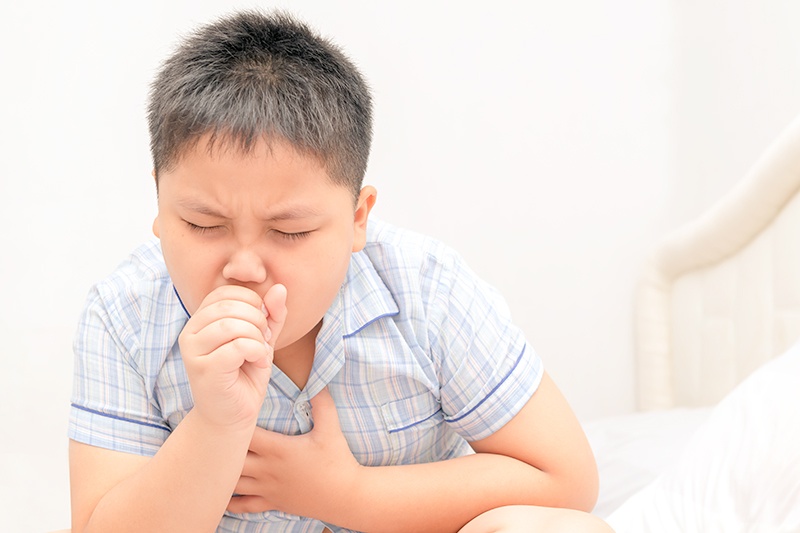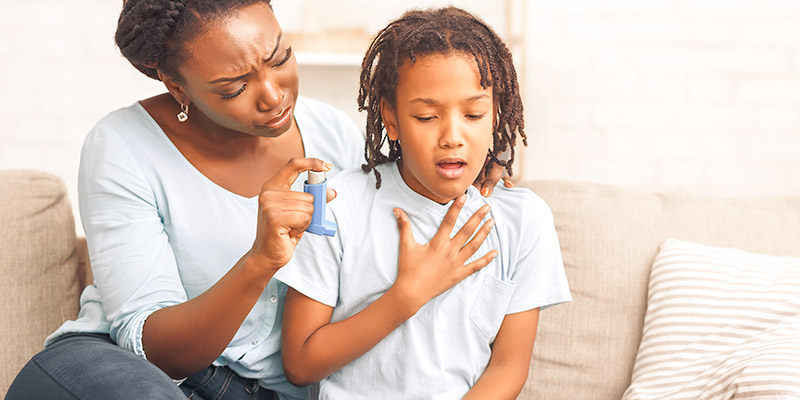It’s a tough time of year for children with asthma. The change in temperature, the spread of respiratory illnesses among friends at school, and exposure to seasonal allergens can trigger asthma attacks, resulting in hospital visits and missed school days. It’s tough for the child and let’s face it, it’s tough for the parents, too.
Asthma is the most common chronic lung disease in children, affecting approximately 6 million children in the U.S., according to the CDC. Unfortunately, there’s no cure for asthma, but with the right treatment, you can keep your child’s symptoms under control and prevent permanent damage to their growing lungs.
What is Asthma?
Asthma is a chronic lung disease that inflames your airways, making them narrow and difficult to breathe through. This causes wheezing and coughing, and when these symptoms are worse than usual, it is called an asthma attack. Asthma is very common in children, usually starting before the age of 5.
Children’s bronchial tubes (airways) which carry air to and from the lungs are already small and narrow. When inflamed by a cold or other illness, their airways become even narrower. Symptoms can vary from a cough lasting days or weeks to serious breathing emergencies. Here are some symptoms to look out for:

- Coughing, especially at night
- Wheezing
- Trouble breathing or rapid breathing
- Frequent chest colds
- Chest tightness
You may notice one or all of these symptoms and think it’s just a cold or even bronchitis, but if these symptoms occur repeatedly, then that is a sign that your child may have asthma.
Causes and Risk Factors of Asthma
While little is known about the causes of asthma, it is known that there are certain factors that raise the risk of asthma in children. These include:

- Exposure to secondhand smoke. This includes in the womb, if the mother smokes.
- Genetics. Children are at greater risk of having asthma if one of their parents has it.
- Race or ethnicity. About 16% of black children have asthma compared to about 7% of white children, according to the CDC.
- Other medical conditions. This includes allergies and obesity.
- Frequent respiratory infections.
- Sex. Asthma is more common in boys as children and girls as teens.
Asthma Triggers
As previously mentioned, when the symptoms are worse than usual, that is called an asthma attack. Asthma attacks can happen when your child is exposed to an asthma trigger. Triggers vary from child to child and can set off different types of asthma:
Allergic asthma, caused by allergens such as:
- Dust mites
- Mold
- Pet dander
- Pollen from grass, trees, flowers, etc.
- Waste from household pests such as rodents and cockroaches
Nonallergic asthma, caused by other triggers such as:
- Cold air
- Medicines
- Household cleansers (chemicals)
- Infections such as cold and flu
- Outdoor air pollution
- Cigarette smoke
Exercise-induced asthma, caused by physical exertion, particularly in dry weather.
When should you consult a doctor?
Early detection can help control symptoms and prevent attacks. Schedule an appointment with your child’s doctor if you notice any of the following behaviors:
- Constant coughing
- Coughing due to physical activity
- Wheezing
- Shortness of breath or rapid breathing
- Complaints of chest tightness
- Recurring bouts of bronchitis or pneumonia
Preventing Asthma Attacks
You’ve taken your child to the doctor and their asthma diagnosis has been confirmed. Now what? Create an action plan! Work with your child’s doctor to come up with a plan that works best for your child’s case. Remember, asthma affects people differently, so what is good for one child is not necessarily good for another. Having a good action plan can help you to track symptoms, record peak flow readings (if your child is old enough to use a peak flow meter), adjust medications, and recognize and treat an asthma attack. The best ways to prevent asthma attacks are:

- Protect your child from triggers listed above.
- Encourage your child to be active. Regular physical activity can strengthen your child’s lungs, so long as their asthma is well-managed.
- Schedule regular doctor check-ups. Asthma changes over time, so it’s important to adjust treatments as needed in order to keep symptoms under control.
- Encourage healthy diet and weight. Being overweight can worsen symptoms and cause other health complications.
- Keep heartburn under control. Acid reflux or heartburn can worsen asthma symptoms. Over-the-counter or prescription medications can help control acid reflux, as can non-acidic foods.
You’ll want to share the action plan you create with all of your child’s caregivers. Make sure your child and anyone looking out for them–babysitters, grandparents, etc.–know where to find the plan and what to do if symptoms flare-up. Provide your child’s school nurse, teachers, and coaches with the plan, so that they’ll know what to do. As your child grows up, he or she will be able to take responsibility for using the plan to manage their asthma. By having a good asthma action plan, you can improve your child’s quality of life, sparing them from frequent attacks that would make them miss school or other activities they enjoy.
What constitutes an emergency?
If, even with your plan, a severe asthma attack occurs, take your child to an emergency room immediately. During a severe asthma attack, you’ll notice your child struggling to breathe. He or she may sweat with a rapid heartbeat and chest pain. You’ll see your child trying so hard to breathe that their sides pull inward and their abdomen is sucked in under their ribs. Asthma attacks vary in severity but can begin with coughing and progress to wheezing and struggling to breathe.
Even if your child is not diagnosed with asthma, you should seek medical attention immediately if experiencing an attack. Neighbors Emergency Center is located right down the road and open 24/7/365, so don’t hesitate to come see us if your child is struggling to breathe.

